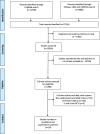Efficacy of more intensive lipid-lowering therapy on cardiovascular diseases: a systematic review and meta-analysis
- PMID: 32660417
- PMCID: PMC7359015
- DOI: 10.1186/s12872-020-01567-1
Efficacy of more intensive lipid-lowering therapy on cardiovascular diseases: a systematic review and meta-analysis
Abstract
Background: Cardiovascular disease is the leading cause of morbidity and mortality with incidence rates of 5-10 per 1000 person-years, according to primary prevention studies. To control hyperlipidemia-a major risk factor of cardiovascular disease-initiation of lipid-lowering therapy with therapeutic lifestyle modification or lipid-lowering agent is recommended. Few systematic reviews and meta-analyses are available on lipid-lowering therapy for the primary prevention of cardiovascular diseases. In addition, the operational definitions of intensive lipid-lowering therapies are heterogeneous. The aim of our study was to investigate whether intensive lipid-lowering therapies reduce greater cardiovascular disease risks in primary prevention settings.
Methods: MEDLINE, EMBASE, and Cochrane Library databases were searched from inception to March 2019 for randomized controlled trials. We used random effects model for overall pooled risk ratio (RR) estimation with cardiovascular events of interest and all-cause mortality rate for the intensive lipid-lowering group using the standard lipid-lowering group as the reference. The Cochrane Risk of Bias Tool was used for quality assessment.
Results: A total of 18 randomized controlled trials were included. The risk reductions in cardiovascular outcomes and all-cause mortality associated with more intensive vs. standard lipid-lowering therapy across all trials were 24 and 10%, respectively (RR 0.76, 95% confidence interval 0.68-0.85; RR 0.90, 95% confidence interval 0.83-0.97); however, the risk reduction varied by baseline LDL-C level in the trial. A greater risk reduction was noted with higher LDL-C level. Intensive lipid-lowering for coronary heart disease protection was more pronounced in the non-diabetic populations than in the diabetic populations.
Conclusions: More intensive LDL-C lowering was associated with a greater reduction in risk of total and cardiovascular mortality in trials of patients with higher baseline LDL-C levels than less intensive LDL-C lowering. Intensive lipid-lowering was associated with a significant risk reduction of coronary heart disease and must be considered even in the non-diabetic populations.
Keywords: All-cause mortality; Cardiovascular outcome; Intensive lipid-lowering; Primary prevention.
Conflict of interest statement
The authors declare that they have no competing interests.
Figures




Similar articles
-
Impact of Lipid-Lowering Therapy on Mortality According to the Baseline Non-HDL Cholesterol Level: A Meta-Analysis.High Blood Press Cardiovasc Prev. 2019 Aug;26(4):263-272. doi: 10.1007/s40292-019-00330-8. Epub 2019 Jul 16. High Blood Press Cardiovasc Prev. 2019. PMID: 31313082
-
Lipoprotein(a) reductions from PCSK9 inhibition and major adverse cardiovascular events: Pooled analysis of alirocumab phase 3 trials.Atherosclerosis. 2019 Sep;288:194-202. doi: 10.1016/j.atherosclerosis.2019.06.896. Epub 2019 Jun 8. Atherosclerosis. 2019. PMID: 31253441
-
Associations between lower levels of low-density lipoprotein cholesterol and cardiovascular events in very high-risk patients: Pooled analysis of nine ODYSSEY trials of alirocumab versus control.Atherosclerosis. 2019 Sep;288:85-93. doi: 10.1016/j.atherosclerosis.2019.07.008. Epub 2019 Jul 12. Atherosclerosis. 2019. PMID: 31349086
-
Lowering LDL cholesterol reduces cardiovascular risk independently of presence of inflammation.Kidney Int. 2018 Apr;93(4):1000-1007. doi: 10.1016/j.kint.2017.09.011. Epub 2017 Nov 14. Kidney Int. 2018. PMID: 29146277 Free PMC article.
-
Intensive LDL cholesterol-lowering treatment beyond current recommendations for the prevention of major vascular events: a systematic review and meta-analysis of randomised trials including 327 037 participants.Lancet Diabetes Endocrinol. 2020 Jan;8(1):36-49. doi: 10.1016/S2213-8587(19)30388-2. Lancet Diabetes Endocrinol. 2020. PMID: 31862150
Cited by
-
Management of High-Risk Hypercholesterolemic Patients and PCSK9 Inhibitors Reimbursement Policies: Data from a Cohort of Italian Hypercholesterolemic Outpatients.J Clin Med. 2022 Aug 11;11(16):4701. doi: 10.3390/jcm11164701. J Clin Med. 2022. PMID: 36012937 Free PMC article.
-
Association of baseline as well as change in lipid levels with the risk of cardiovascular diseases and all-cause deaths.Sci Rep. 2021 Apr 1;11(1):7381. doi: 10.1038/s41598-021-86336-6. Sci Rep. 2021. PMID: 33795701 Free PMC article.
-
Osteopontin Gene Polymorphisms Are Associated with Cardiovascular Risk Factors in Patients with Premature Coronary Artery Disease.Biomedicines. 2021 Nov 2;9(11):1600. doi: 10.3390/biomedicines9111600. Biomedicines. 2021. PMID: 34829826 Free PMC article.
-
Improving service efficiency and throughput of cardiac surgery patients using Monte Carlo simulation: a queueing setting.Sci Rep. 2022 Dec 8;12(1):21217. doi: 10.1038/s41598-022-25689-y. Sci Rep. 2022. PMID: 36481779 Free PMC article.
-
Whether and Why Do We Need a Vaccine Against Atherosclerosis? Can We Expect It Anytime Soon?Curr Atheroscler Rep. 2024 Mar;26(3):59-71. doi: 10.1007/s11883-023-01186-z. Epub 2024 Jan 2. Curr Atheroscler Rep. 2024. PMID: 38165521 Free PMC article. Review.
References
-
- Lin C-F, Chang Y-H, Chien S-C, Lin Y-H, Yeh H-Y. Epidemiology of dyslipidemia in the Asia Pacific region. Int J Gerontol. 2018;12:2–6. doi: 10.1016/j.ijge.2018.02.010. - DOI
-
- National Cholesterol Education Program (NCEP) Expert Panel on Detection, Evaluation, and Treatment of High Blood Cholesterol in Adults (Adult Treatment Panel III) Third Report of the National Cholesterol Education Program (NCEP) Expert Panel on Detection, Evaluation, and Treatment of High Blood Cholesterol in Adults (Adult Treatment Panel III) final report. Circulation. 2002;106:3143–3421. doi: 10.1161/circ.106.25.3143. - DOI - PubMed
-
- Jellinger PS, Handelsman Y, Rosenblit PD, Bloomgarden ZT, Fonseca VA, Garber AJ, et al. American Association of Clinical Endocrinologists and American College of endocrinology guidelines for management of dyslipidemia and prevention of cardiovascular disease. Endocr Pract. 2017;23(Suppl 2):1–87. doi: 10.4158/EP171764.APPGL. - DOI - PubMed
Publication types
MeSH terms
Substances
LinkOut - more resources
Full Text Sources
Medical

